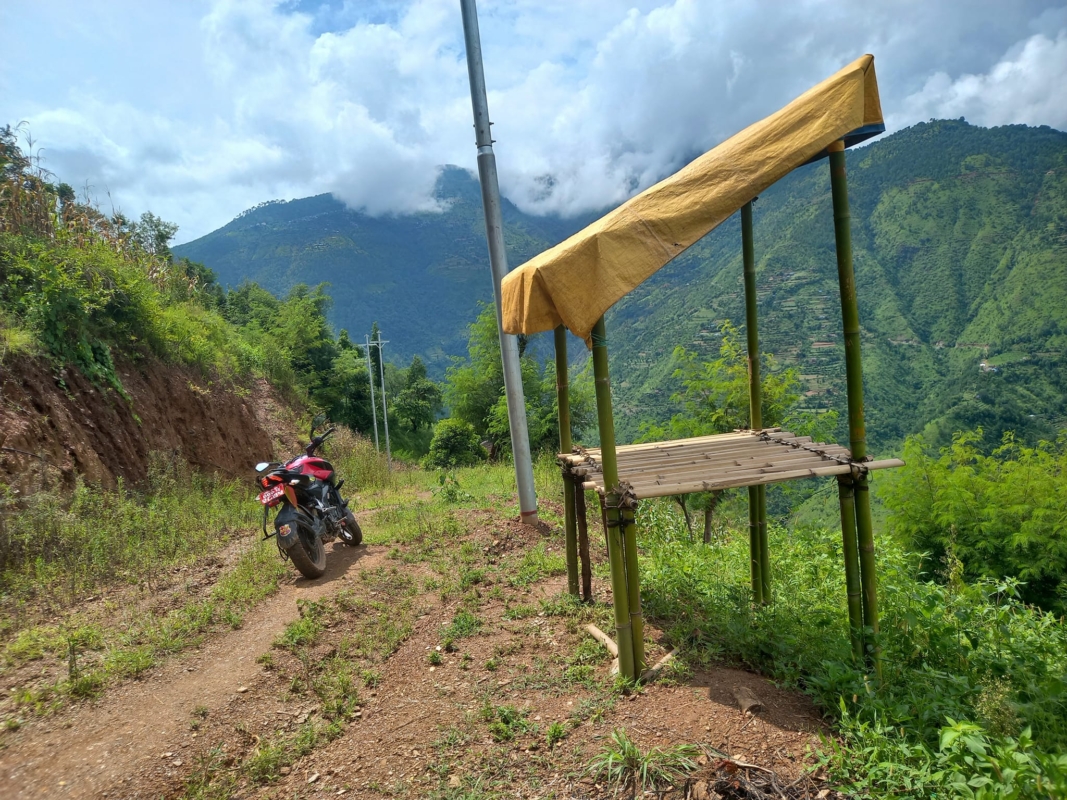Table of Contents
ToggleBhanjang Travel Guide
Mane Bhanjang also spelt as Maney Bhanjyang, is a quaint village located on the India-Nepal border in the Darjeeling district. It is famous for being the starting point of the Sandakphu trek, which is one of the most scenic trekking routes in the Eastern Himalayas.
How to Reach Mane Bhanjang
By Air:
- Nearest Airport: Bagdogra Airport (IXB) (About 90 km from Mane Bhanjang).
- From the airport, you can hire a taxi to Mane Bhanjang, or take a shared taxi to Darjeeling and then transfer to Mane Bhanjang.
By Train:
- Nearest Railway Station: New Jalpaiguri (NJP) (About 85 km from Mane Bhanjang).
- From NJP, shared taxis or private cabs are available to Darjeeling, from where you can continue to Mane Bhanjang.
By Road:
- From Darjeeling: Mane Bhanjang is 26 km away. You can hire a cab or take shared jeeps that operate from Darjeeling to Mane Bhanjang.
- From Siliguri/NJP/Bagdogra: You can either take a direct cab to Mane Bhanjang or travel to Darjeeling first.
Where to Stay in Mane Bhanjang
- Homestays: Mane Bhanjang has a few small, family-run homestays offering cozy accommodations with local food. These are ideal for trekkers.
- Hotels: Limited, but there are small budget hotels. Most people stay here for a night before starting their trek.
- Darjeeling: Some prefer staying in Darjeeling, which has a wider range of accommodations, and traveling to Mane Bhanjang early in the morning to start the trek.
Trekking from Mane Bhanjang
1. Sandakphu Trek
- Duration: 4-6 days (round trip)
- Difficulty: Moderate
- Highest Altitude: Sandakphu (3,636 meters / 11,929 feet)
- Route: Mane Bhanjang → Tumling → Kalapokhri → Sandakphu → Phalut (optional) → Return
- Key Attractions:
- Panoramic views of Mt. Everest, Mt. Kanchenjunga, Mt. Lhotse, and Mt. Makalu.
- Singalila National Park with rich wildlife (including red pandas).
- Picturesque landscapes, rhododendron forests, and small Himalayan villages.
- The iconic “Sleeping Buddha” view (Kanchenjunga range).
2. Singalila Ridge Trek
- This trek overlaps with the Sandakphu trek and is part of the same trail.
- You can extend the trek to Phalut, which offers another stunning viewpoint of the Himalayas.
Other Activities
Land Rover Ride
For those who do not wish to trek, there is an option to take a thrilling ride on vintage Land Rovers to Sandakphu. These 4×4 vehicles, remnants of the British colonial era, are well-suited for the rugged terrain.
Explore Singalila National Park
- Wildlife: Red pandas, Himalayan black bears, leopards, and various bird species.
- Permits: Required for entry into the park, which can be obtained at Mane Bhanjang.
Village Exploration
- Local Culture: Interact with the warm and hospitable locals, primarily of Nepali and Tibetan origin.
- Cuisine: Enjoy traditional Nepali and Tibetan food, including momo, thukpa, and dal-bhat.
When to Visit
Best Time for Trekking:
- Spring (March to May): The weather is pleasant with clear skies and blooming rhododendrons.
- Autumn (October to November): Crisp air and panoramic mountain views are best during this time.
Avoid Monsoons (July to September):
- Heavy rainfall can make trekking dangerous and obscure mountain views.
Winter (December to February):
- The area sees heavy snowfall, and while trekking is still possible, it’s more challenging due to freezing temperatures and snow-covered trails.
What to Pack
- Warm Clothing: Layered clothing, fleece jackets, thermals (especially for higher altitudes).
- Trekking Gear: Sturdy trekking shoes, trekking poles, gloves, and a rain jacket.
- Essentials: Sunscreen, sunglasses, a hat, a water bottle, and personal medication.
- Camera: For capturing the stunning vistas!
Permits and Guides
- Permit for Singalila National Park: Required. You can get it at the Forest Department’s checkpoint in Mane Bhanjang.
- Trekking Guide: It’s mandatory to hire a guide if you plan to trek, and they can be arranged in Mane Bhanjang.
- Cost of Guide: INR 800-1,200 per day (varies depending on the guide and group size).
Things to Keep in Mind
- Acclimatization: Since you will be trekking at high altitudes, take time to acclimatize to avoid altitude sickness.
- Water: Carry enough water for the trek, although there are some points along the trail where you can refill.
- Waste Management: Follow a strict no-plastic policy and take all waste back to a disposal point.
Sample Itinerary for Sandakphu Trek
Day 1: Arrive at Mane Bhanjang, stay overnight.
Day 2: Trek to Tumling (11 km) – beautiful village offering great views.
Day 3: Trek to Kalapokhri (12 km) – pass through forests and small settlements.
Day 4: Trek to Sandakphu (6 km) – ascend to the highest point in West Bengal with incredible mountain views.
Day 5: Return to Mane Bhanjang or continue to Phalut if extending the trek.
Important Contacts
- Local Trekking Agencies: Available in Mane Bhanjang to help you arrange permits, guides, and accommodations along the trek.
- Forest Department Office: Located in Mane Bhanjang for obtaining permits.
Mane Bhanjang, with its serene environment and proximity to the stunning Himalayan peaks, offers a perfect blend of adventure and nature. Whether you’re a trekker aiming for Sandakphu or just seeking a peaceful getaway, this village is an ideal starting point for an unforgettable experience.
Here’s the road travel guide to Mane Bhanjang with a detailed road trip itinerary for travelers who prefer exploring the region by road instead of trekking. This guide covers key destinations accessible by vehicle, using Mane Bhanjang as the base.
Road Trip to Mane Bhanjang and Beyond
Mane Bhanjang is not only a gateway for trekkers but also a scenic destination for those who prefer exploring the Eastern Himalayas by road. The region is famous for its stunning views, serene villages, and old-world charm. With a unique experience of traveling through winding mountain roads, lush forests, and charming hill stations, this trip offers unforgettable experiences.
Itinerary for a 5-Day Road Trip
Day 1: Arrival in Darjeeling
- Route: Bagdogra/NJP to Darjeeling (80 km, 3 hours)
- Stay: Darjeeling
- Key Highlights:
- Arrive at Darjeeling via Bagdogra or NJP (New Jalpaiguri Railway Station).
- Spend the day exploring Darjeeling with its tea estates, colonial charm, and iconic attractions.
- Visit the Tiger Hill at sunrise for your first glimpse of the Kanchenjunga range.
- Explore Batasia Loop and the Ghoom Monastery.
Day 2: Darjeeling to Mane Bhanjang
- Route: Darjeeling to Mane Bhanjang (26 km, 1.5 hours)
- Stay: Mane Bhanjang
- Key Highlights:
- After breakfast, leave for Mane Bhanjang, a peaceful village located along the Indo-Nepal border.
- Explore the village, visit local monasteries, and interact with locals to learn about their culture.
- Get a feel for the adventure ahead with some light exploration of the surroundings.
Day 3: Mane Bhanjang to Tumling via Land Rover
- Route: Mane Bhanjang → Tumling (12 km, 2-3 hours by vintage Land Rover)
- Stay: Tumling (homestay or guesthouse)
- Key Highlights:
- Take a thrilling ride in an old British-era Land Rover to Tumling, a scenic village on the Indo-Nepal border.
- Enjoy the breathtaking view of the Kanchenjunga range and explore the tranquil village.
- Tumling offers mesmerizing landscapes, with its rolling hills and vibrant meadows.
- Witness a stunning sunset over the Himalayan peaks.
Day 4: Tumling to Sandakphu (Road or Jeep Adventure)
- Route: Tumling → Sandakphu (18 km, 3-4 hours by Jeep or Land Rover)
- Stay: Sandakphu (homestay or lodge)
- Key Highlights:
- Continue your Land Rover journey or hire a Jeep for a rough but scenic ride to Sandakphu (the highest point in West Bengal).
- At 3,636 meters, Sandakphu offers 360-degree panoramic views of four of the world’s highest peaks – Everest, Kanchenjunga, Lhotse, and Makalu.
- Relax in the evening with the spectacular view of the “Sleeping Buddha” (Kanchenjunga Range) stretching across the horizon.
Day 5: Sandakphu to Phalut and Back to Mane Bhanjang
- Route: Sandakphu → Phalut (21 km, 3-4 hours) → Back to Mane Bhanjang
- Stay: Mane Bhanjang
- Key Highlights:
- For the adventurous, drive to Phalut, another amazing vantage point offering pristine views of the Himalayas.
- The journey takes you deeper into the Singalila National Park, where you may spot rare wildlife like red pandas and exotic birds.
- After enjoying the views at Phalut, return to Mane Bhanjang for an overnight stay.
Optional Day 6: Mane Bhanjang to Darjeeling and Return to Bagdogra/NJP
- Route: Mane Bhanjang → Darjeeling → Bagdogra/NJP (80 km, 4-5 hours)
- Key Highlights:
- Head back to Darjeeling for a leisurely day or shopping for souvenirs.
- Continue your journey back to Bagdogra/NJP for your return trip home.
Key Stops & Attractions Along the Route
1. Darjeeling
- Famous for its tea gardens and colonial-era architecture, Darjeeling offers a chance to visit popular spots like the Himalayan Mountaineering Institute, Padmaja Naidu Zoological Park, and Darjeeling Ropeway.
2. Mane Bhanjang
- Known as the starting point of the Sandakphu trek, Mane Bhanjang is a quiet village where you can experience local culture and enjoy serene landscapes.
3. Tumling
- A picturesque village on the border between India and Nepal. It offers stunning views of Kanchenjunga and has a peaceful environment ideal for relaxation and short hikes.
4. Sandakphu
- At 3,636 meters, it is the highest point in West Bengal and offers awe-inspiring views of four of the five highest peaks in the world. The road journey is rugged but worth it for the incredible scenery.
5. Phalut
- A less-visited gem on the Singalila Ridge, Phalut provides a closer view of Kanchenjunga and is surrounded by pristine nature. The drive offers an off-road adventure experience.
Travel Tips for the Road Trip
- Weather Conditions:
- Be prepared for cold weather at higher altitudes (Sandakphu and Phalut) even in summer.
- During the monsoon (July to September), the roads can be slippery and prone to landslides.
- Vehicle Considerations:
- The terrain from Mane Bhanjang to Sandakphu is rugged, so it is essential to hire a 4×4 vehicle or Land Rover, particularly for the Sandakphu-Phalut leg.
- Check with local agencies for vehicle rentals. They are available in Mane Bhanjang.
- Permits:
- You will need a permit to enter the Singalila National Park. This can be obtained at the Forest Department Office in Mane Bhanjang.
- Accommodation:
- Basic accommodation (lodges and homestays) is available in Tumling, Sandakphu, and Phalut. These are often family-run and offer warm hospitality but with limited facilities.
- Pre-book your stays during peak trekking seasons (March-May and October-November).
- Food:
- Along the route, you will mostly find simple, local cuisine such as momos, thukpa, and dal-bhat (rice and lentils).
- It’s advisable to carry some snacks and bottled water as there are long stretches without any eateries, especially on the way to Sandakphu and Phalut.
- Best Time to Visit:
- Spring (March-May): Clear skies and rhododendron blooms.
- Autumn (October-November): Best for clear mountain views and pleasant weather.
- Avoid monsoon season (July-September) due to landslides and poor road conditions.
Road Trip Cost Estimate
- Vehicle Hire (Darjeeling to Sandakphu and Back): INR 5,000-6,000 per day for a Land Rover or 4×4.
- Accommodation (per night): INR 1,000-2,000 depending on location and type of stay.
- Food: INR 300-500 per day for basic meals.
- Permits: INR 100-200 per person for Singalila National Park entry.
This itinerary gives you a blend of road trip adventure, Himalayan views, and cultural experiences, all without the physical demands of trekking. Would you like more details on any specific leg of the journey

